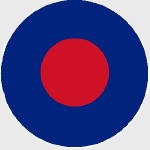Hobby Master HA2301 RAF Bristol Beaufighter Mk. X Torpedo Bomber - No.236 Squadron, Coastal Group 16, Coastal Command, RAF North Coates, England, 1944 (1:72 Scale)
"Having Watched, Bring Word"
- Motto of No.236 Squadron
 Developed as a private venture by the Bristol Aeroplane Company, the Beaufighter was a two-seat all-metal fighter using components from the Beaufort torpedo-bomber. First flown on July 17th, 1939, the Beaufighter eventually equipped 52 RAF squadrons, giving outstanding service during World War II, in particular as a night-fighter and torpedo-bomber (where the aircraft were affectionately known as 'Torbeaus').
Developed as a private venture by the Bristol Aeroplane Company, the Beaufighter was a two-seat all-metal fighter using components from the Beaufort torpedo-bomber. First flown on July 17th, 1939, the Beaufighter eventually equipped 52 RAF squadrons, giving outstanding service during World War II, in particular as a night-fighter and torpedo-bomber (where the aircraft were affectionately known as 'Torbeaus').
Entry into Fighter Command service came during August 1940 with the Fighter Interception Unit at Tangmere. The following month, five squadrons received the Mark 1F equipped with Mark IV Air Intercept radar for night-fighter duties although the type's first kill wasn't until November of that year. The Beaufighter continued as a night-fighter until 1943, and the last aircraft (a TT10) was not retired from RAF service until 1960, nearly 21 years after the type's first flight.
1941 saw the development of the Beaufighter Mk.IC long-range heavy fighter. This new variant entered service in May 1941 with a detachment from No. 252 Squadron operating from Malta. The aircraft proved so effective in the Mediterranean against shipping, aircraft and ground targets that Coastal Command became the major user of the Beaufighter, replacing the obsolete Beaufort and Blenheim.
Coastal Command began to take delivery of the up-rated Mk.VIC in mid 1942. By the end of 1942, Mk VICs were being equipped with torpedo-carrying gear, enabling them to carry the British 18-inch or the US 22.5-inch torpedo externally. The first successful torpedo attacks by Beaufighters came in April 1943, with No. 254 Squadron sinking two merchant ships off Norway.
The Hercules Mk XVII, developing 1,735 hp at 500 feet was installed in the Mk VIC airframe to produce the TF Mk.X (Torpedo Fighter) - commonly known as the "Torbeau." The Mk X became the main production mark of the Beaufighter. The strike variant of the "Torbeau" was designated the Mk.XIC. Beaufighter TF Xs would make precision shipping attacks at wave-top height with torpedoes or rockets. Early models of the Mk Xs carried metric-wavelength ASV (air-to-surface vessel) radar with "herringbone" antennae carried on the nose and outer wings, but this was replaced in late 1943 by the centimetric AI Mark VIII radar housed in a "thimble-nose" radome, enabling all-weather and night time attacks.
The North Coates Strike Wing (Coastal Command), based at RAF North Coates on the Lincolnshire coast, developed attack tactics combining large formations of Beaufighters on anti-flak suppression with cannon and rockets while the Torbeaus attacked on low level. These tactics were put into practice in mid 1943 and in a 10 month period 27,000 tonnes of shipping were sunk. Tactics were further adapted when shipping was moved from port during night hours. North Coates Strike Wing operated as the largest anti-shipping force of the Second World War, and accounted for over 150,000 tons of shipping and 117 vessels for a loss of 120 Beaufighters and 241 aircrew killed or missing. This was half the total tonnage sunk by all strike wings between 1942-45.
Pictured here is a 1:72 scale RAF Bristol Beaufighter Mk. X torpedo bomber that was attached to No.236 Squadron, Coastal Group 16, Coastal Command, then deployed to RAF North Coates, England, during 1944.
Sold Out!
Dimensions:
Wingspan: 9-3/4-inches
Length: 7-inches
Release Date: March 2009
Historical Account: "Torbeaus" - Reformed as a fighter squadron at Stradishall on October 31st, 1939, No.236 Squadron was initially equipped with the Blenheim bomber, which it took to Bircham Newton in February 1940, where the unit was transferred to Coastal Command. In April, it moved to Speke, where it rejoined Fighter Command. The following month it was moved to Filton to fly defensive patrols over the Channel, but in July a move to Thorney Island saw it back in Coastal Command, where it stayed for the rest of the war.
From August 1940, it operated from bases in the South West carrying out anti-shipping patrols over the Channel and Irish Sea, having re-equipped with Beaufighters in October 1941. In February 1942, it transferred to Wattisham and was reduced to cadre. It received new Beaufighters in March and resumed its previous duties, although these were now flown over the North Sea. Moreover it operated detachments in the South West to undertake similar duties over the Bay of Biscay. In September 1942, the squadron moved to North Coates and in April 1943 became a part of the strike wing formed there, operating as such until the end of the war. The squadron disbanded on May 25th, 1945.


